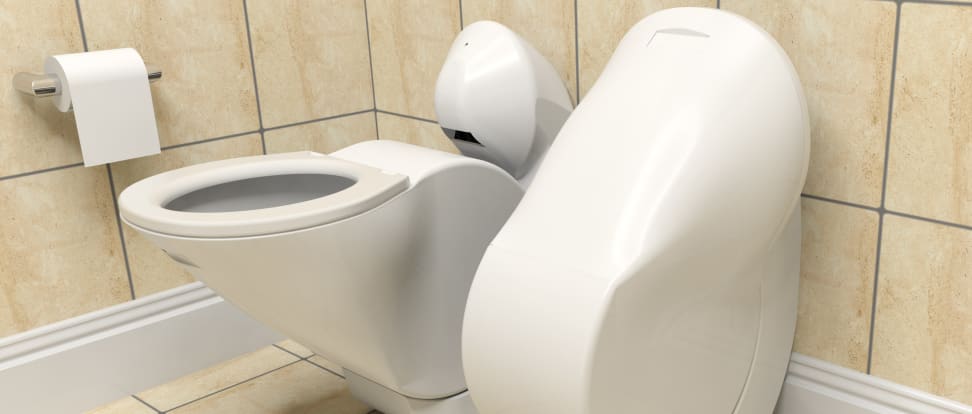Futuristic Toilet Folds Up to Save You Space
The Iota is small, efficient, and hygienic: What's not to love?
 Credit:
Credit:
Recommendations are independently chosen by Reviewed's editors. Purchases made through the links below may earn us and our publishing partners a commission.
You’ve heard about people trying to reinvent the wheel, but what about the toilet? Cue the Iota: a new folding toilet created by Gareth Humphreys and Elliott Whiteley, design students at the University of Huddersfield in England. With an unusual hinge-based design that results in high efficiency and easy cleaning, the Iota could be poised to claim the crown as king of the porcelain thrones.
The key attraction of the Iota is its unusual folding design. When you need to use the toilet, the bowl flips down into the regular position. In this position, the internal u-bend is disengaged from the pipes in the floor. When you finish, flipping the bowl up towards the wall reconnects the u-bend with those pipes and activates a high-pressure jet of water to flush your waste away.
According to the designers, an average toilet today uses just over 1.5 gallons of water per flush. The Iota, however, needs just two-thirds of a gallon—that’s a reduction of more than 50%.
It’s also about one-third smaller than a standard toilet, making this a great idea for city apartments where living spaces—and the attached bathrooms—are increasingly cramped.
The Iota’s design could also lead to a more hygienic bathroom. The rimless bowl is easier to clean, and folding the toilet up to flush means fewer water droplets will fly out as water and waste are drained away. Plus, the outer panels are designed to be removable, making it easy to repair any internal problems as well as replace any damaged or cracked portion of the exterior.
As with any concept design, there are questions aplenty. Some are functional: What do you do if there’s a clog? A plunger won’t be of much use if the pipes aren’t connected when the bowl is down. For that matter, what if your... output is more than the small toilet can handle?
Others have to do with the viability of the odd hinged design: What happens if the bowl isn't folded up all the way? Could it fall back down, potentially cracking the floor or the bottom of the bowl? After years of use, what happens if the hinge or seals weaken?
{{ photo_gallery "Iota" }}
Since the Iota is smaller, it’s also closer to the ground. That could make it trickier to use for folks with back or knee problems, people with certain handicaps, and the elderly. A variant that could sit higher up on the wall is certainly possible, but it’s a challenge yet to be addressed in the Iota’s initial design stage.
In recent years we've seen a wave of updated designs for household objects we'd always assumed would forever remain unchanged—especially from European designers. For example, an Austrian artist has been working on unusual folding doors reminiscent of origami. Like the Iota, they represent a radical break from years and years of traditional design.
Extra kudos go to Humphreys and Whiteley for taking something as mundane as a toilet and approaching it in such an effective and aesthetically pleasing manner. Should the Iota become available as a viable commercial product, we feel certain its incredible efficiency and attractive design could easily flush away the competition.
Images: Gareth Humphreys & Elliott Whiteley Video: EG Visuals

